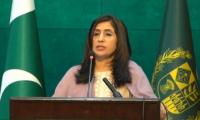Some recent economic news gives hope that the economy is less fragile than many people assumed. One useful indicator of a revival of confidence by investors is the slight bounce back of the rupee’s value against the dollar. Foreign currency markets are notoriously prone to bouts of pessimism or overconfidence and exchange rates tend to overshoot past their equilibrium values regularly so a correction was overdue.
Another indicator is that the stock market appears to have stopped its downward slide – albeit with help from government-owned mutual fund companies. What is still worrisome though is the fiscal deficit that is close to five percent of GDP but the upcoming budget will no doubt be addressing this issue.
The improvement in economic outlook is in no small measure a result of the change in the economic team for which the PTI government has been pilloried as kowtowing to the IMF. To the critics a technocratic setup is anathema because in their view those elected to parliament are the ones mandated to govern and should therefore also be held to account for their acts of commission and omission while in positions of responsibility.
One must however remember that the reliance on technocrats to formulate economic policy has been the norm in most of Pakistan’s history. For example, Z A Bhutto appointed Feroze Qaiser, a chartered accountant by profession, as his economic adviser. Ziaul Haq invited the eminent economist, Mahbubul Haq, to serve as the country’s finance minister while Benazir Bhutto had V A Jafarey to guide her during her two stints as prime minister.
Musharraf’s regime was chock-full of technocrats – including his hand-picked prime minister, Shaukat Aziz, a renowned international banker. The last PPP government had Abdul Hafeez Sheikh as finance minister (2010-2013); he is now reprising his previous role in the current government. In this regard at least ‘Naya Pakistan’ is not so different from what came earlier. And perhaps that’s not such a bad thing either.
Those who assail the reliance on technocrats should pay heed to the wisdom attributed to Deng Xiaoping, the architect of China’s growth miracle who said: “It doesn’t matter whether a cat is white or black, as long as it catches mice.” What Deng essentially meant was that pragmatism should trump ideology. China’s growth rate over the last 40 years and its status today as the world’s largest economy (in purchasing power parity terms) is testimony to the importance of what Deng believed.
Some part of the blame for our current economic predicament should also be placed squarely at the door of the private sector in this country. For instance, we are reminded time and again that the textile industry is the backbone of this country’s economy and therefore deserving of all types of governmental assistance since the sector as a whole accounts for about 60 percent of Pakistan’s exports. However, past performance by the textile sector is a cause of concern and underlines weaknesses in Pakistan’s ability to generate sufficient foreign currency and to diversify its commodity export base.
According to the State Bank of Pakistan’s statistics, Pakistan’s annual exports of textiles and textile products in 2000 were $5.8 billion which grew to $12.9 billion by 2016. This translates into a compounded annual growth rate of 5.1 percent. In comparison, Bangladesh (which started garment manufacturing much later than Pakistan) exported ready-made garments worth $4.9 billion in 2000 that soared to $28.1 billion in 2016, yielding a compounded annual growth rate of a stunning 11.5 percent.
Putting each country’s performance in a wider context, Pakistan’s share of the global textile and apparel export market was 1.63 percent in 2000 and grew only marginally to 1.76 percent in 2016. Bangladesh, on the other hand, expanded its market share from 1.38 percent in 2000 to 3.83 percent in 2016 – about a three-fold leap in its international market share.
William Easterly, an economics professor at New York University, points out in his book, ‘The Elusive Quest for Growth’, that Bangladesh started its garments industry from scratch in 1979 when a Bangladeshi entrepreneur teamed up with the South Korean conglomerate Daewoo Corporation to establish ‘Desh Garments’. Desh started production of shirts for the international market in 1980. But the astonishing fact that Professor Easterly highlights is that the lone Desh factory had, directly or indirectly, spawned over 700 garment manufacturers in Bangladesh by 1985 as its management and workers acquired knowhow and left to set up their own businesses.
Professor Easterly attributes a large part of Bangladeshi success in garment exports to the initial training provided to Desh workers by Daewoo which resulted in an ever widening virtuous circle of industry specific knowledge. This is an instance of a massive return to investment in knowledge which Thomas Jefferson, the principal author of the American Declaration of Independence and the third US president, likened to a candle emitting light: “Knowledge is like a candle. Even as it lights a new candle, the strength of the original flame is not diminished.” Professor Easterly however, puts it more prosaically: “Knowledge leaks”.
Why Pakistan’s major industrial sector fell behind in comparison to Bangladesh, despite the fact that Pakistan first entered the field of textiles in the 1950s, is probably the result of a number of factors (no doubt there are countless documents prepared by foreign consultants gathering dust in the various chambers of commerce and government offices). However, if we are to push ahead with an export-led revival then the problems faced by this sector need to be comprehensively addressed through an ongoing dialogue between the private parties concerned and the government.
The immediate issue facing Pakistan today is one of having sufficient foreign currency to make repayments of its foreign currency obligations – which is why the country has turned to the IMF for assistance.
One of the reasons for the liquidity crunch is of course the repayment of loan obligations necessitated by the projects implemented due to the China-Pakistan Economic Corridor (CPEC) agreement. CPEC is undoubtedly of great benefit to the country’s development as it focuses on developing the country’s energy infrastructure and interconnecting the country cities through highway links but the projects inked under this agreement are for the most part long-lived and therefore expected to generate benefits extending over 30 years and more.
Anybody with an iota of business sense would recognize, however, that a borrower who intends to repay a loan does not borrow with the obligation to make front-loaded repayments when the benefits from the project financed by that loan arise for the most part at a much later stage. This is why one doubts whether any serious cost-benefit analysis was done when the CPEC framework agreement was initiated.
Because the country has spent (and misspent) beyond its means for far too long, the only alternatives to the IMF loan were to: (a) default on our international debt obligations; (b) negotiate a rescheduling of the CPEC loans; and (c) let the foreign exchange value of the rupee undergo a free fall.
The first option would make Pakistan an international pariah so it can be ruled out as a non-starter, whereas the second is unlikely to happen. The third option is dangerous for a variety of reasons – perhaps more so than anything because it could unleash a period of hyperinflation in the country and, going by the experience of Venezuela or Zimbabwe, that is not a desirable situation. Unfortunately there is no choice other than fiscal austerity (euphemistically termed ‘fiscal consolidation’ by economists) for the next two to three years. One can only hope that the poor in this country are spared the worst privations in the upcoming budget.
The writer is a group director at the Jang Group.
Email: iqbal.hussain@janggroup. com.pk
People stand in line up as election officials check their ballot papers during voting general election at a polling...
Women show their voter identity cards as they stand in a queue before casting their votes in Agartala. — PTIThe 18th...
Former prime minister Imran Khan. — Instagram/ imrankhan.ptiAn old saying has it that “when you dance with the...
Kashmiris in Indian illegally occupied Kashmir protesting against the Indian occupation as the forces of India looked...
A representational image showing residents walking at a wholesale market in Karachi. — AFP/FileOnce again there is...
A representational image showing late Pakistani human rights activist and Supreme Court lawyer Asma Jahangir. —...







